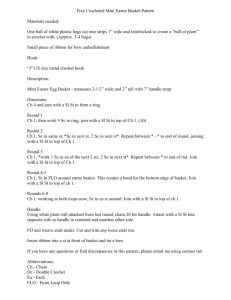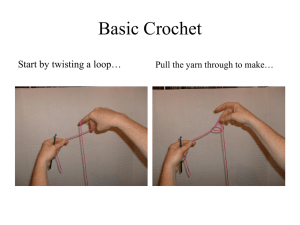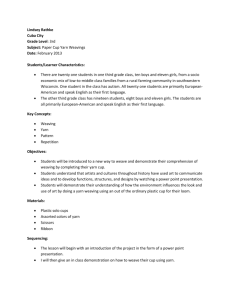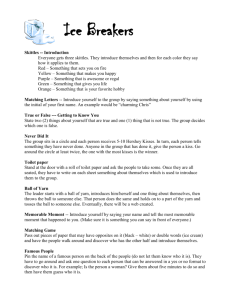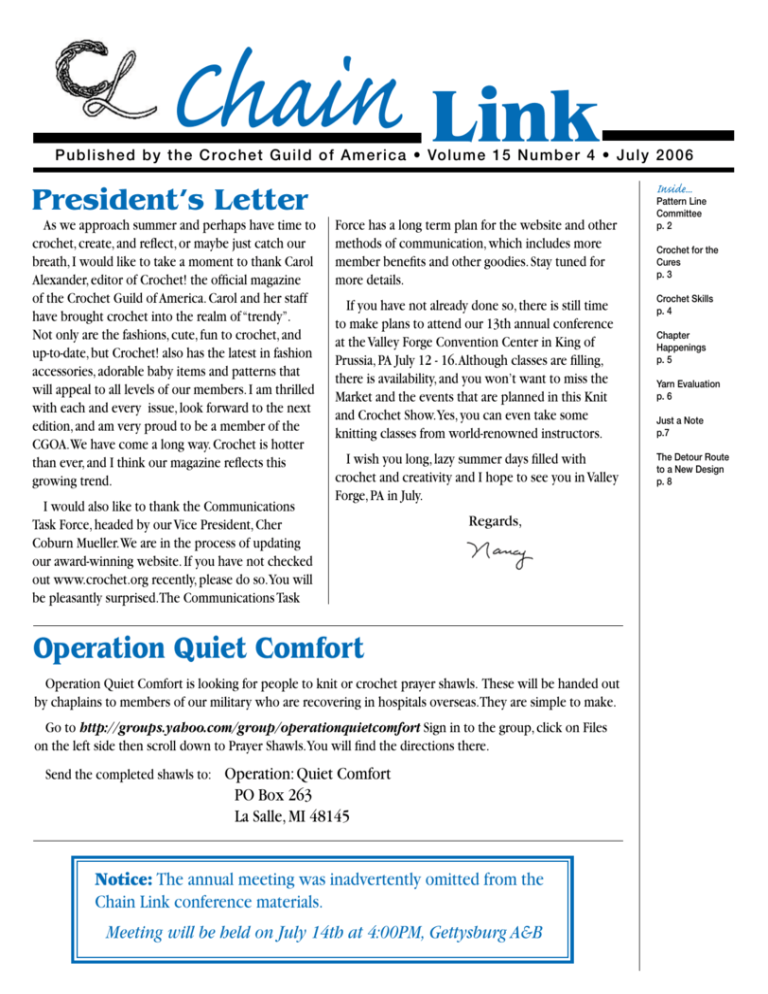
Chain Link
P u b l i s h e d b y the Crochet Guild of America • Volume 15 Number 4 • Ju l y 2 0 0 6
President’s Letter
As we approach summer and perhaps have time to
crochet, create, and reflect, or maybe just catch our
breath, I would like to take a moment to thank Carol
Alexander, editor of Crochet! the official magazine
of the Crochet Guild of America. Carol and her staff
have brought crochet into the realm of “trendy”.
Not only are the fashions, cute, fun to crochet, and
up-to-date, but Crochet! also has the latest in fashion
accessories, adorable baby items and patterns that
will appeal to all levels of our members. I am thrilled
with each and every issue, look forward to the next
edition, and am very proud to be a member of the
CGOA. We have come a long way. Crochet is hotter
than ever, and I think our magazine reflects this
growing trend.
I would also like to thank the Communications
Task Force, headed by our Vice President, Cher
Coburn Mueller. We are in the process of updating
our award-winning website. If you have not checked
out www.crochet.org recently, please do so.You will
be pleasantly surprised.The Communications Task
Force has a long term plan for the website and other
methods of communication, which includes more
member benefits and other goodies. Stay tuned for
more details.
Pattern Line
Committee
p. 2
Crochet for the
Cures
p. 3
If you have not already done so, there is still time
to make plans to attend our 13th annual conference
at the Valley Forge Convention Center in King of
Prussia, PA July 12 - 16. Although classes are filling,
there is availability, and you won’t want to miss the
Market and the events that are planned in this Knit
and Crochet Show.Yes, you can even take some
knitting classes from world-renowned instructors.
Crochet Skills
p. 4
I wish you long, lazy summer days filled with
crochet and creativity and I hope to see you in Valley
Forge, PA in July.
The Detour Route
to a New Design
p. 8
Regards,
Operation Quiet Comfort
Operation Quiet Comfort is looking for people to knit or crochet prayer shawls. These will be handed out
by chaplains to members of our military who are recovering in hospitals overseas.They are simple to make.
Go to http://groups.yahoo.com/group/operationquietcomfort Sign in to the group, click on Files
on the left side then scroll down to Prayer Shawls.You will find the directions there.
Send the completed shawls to: Operation: Quiet Comfort
Inside...
PO Box 263
La Salle, MI 48145
Notice: The annual meeting was inadvertently omitted from the
Chain Link conference materials.
Meeting will be held on July 14th at 4:00PM, Gettysburg A&B
Chapter
Happenings
p. 5
Yarn Evaluation
p. 6
Just a Note
p.7
Crochet Guild
of America
2006
Officers &
Directors
President
Nancy Brown
Vice President
Cher Coburn-Mueller
Secretary
Treva McCain
Treasurer
John Boggs
Directors
Rita Weiss
Vashti Braha
Jacque Kurman
CGOA Pattern Line Committee
Seeks Your Designs
The Pattern Line Committee invites CGOA members
to submit original designs to us for consideration
for the exciting CGOA Pattern Line. See the CGOA
website for photos of the complete line.
Currently we are only seeking designs for “upscale
fashions.” In order to understand what we mean
by “upscale,” take a look at crochet in catalogs,
department stores and fashion runways. Also, keep
an eye on what “youth on the street” are wearing; it
can be inspiring! We also require that the fashions
are designed in yarns found in local yarn shops, NOT
Michaels or JoAnn or other mass market craft stores. We cannot compete with the companies that produce
patterns for mass-market yarns and give them away for
free. As far as accessories are concerned, we cannot
accept just a hat or just a necklace design. We need a
complete “ensemble” of hat AND purse, for example,
in order for the pattern to look complete and for the
best photographic advantage.
Recently there has been some discussions on
various lists about rejections of submissions to the
CGOA Pattern Line. Yes, rejection is a part of being
a crochet designer. However, the Pattern Line
Committee would like to offer some background
information about how our committee works in order
to help all designers, novice or experienced, have
more success in submitting designs to us. We hope
it will be a win-win for both the designer and the
pattern line.
Jackie Young, is an all-time best seller. This is a fitting
tribute to Jackie, who originated the pattern line as a
dedicated volunteer back in 2000.
We are privileged to have a group of volunteers
on the committee who are fashion-conscious and
understand how to interpret trends. We also have a
dynamite volunteer pattern editor who produces topnotch instructions. In order to minimize our costs,
we are launching a new approach and are forming
relationships with yarn manufacturers who wish to
underwrite the cost of pattern production. Soon,
we will unveil two new designs, one sponsored by
South West Trading Company and another sponsored
by DMC Corporation. We are very excited about
the potential of this approach and appreciate the
trust that has been put in our committee by these
two yarn companies. If you have a favorite yarn or
yarn company and/or have a relationship with a yarn
manufacturer, please consider submitting designs to
us using those yarns. We will handle setting up the
sponsorships
If you have designs you would like us to consider,
please send an electronic swatch and sketch to
mjscensny@wowway.com. We work at the Direction
of our Liaison from the CGOA Board, Vashti Braha,
and if you have any questions or would like to
volunteer to serve on this committee, please contact
her at vashtirama@gmail.com
Pattern Line Committee
The vast majority of the CGOA patterns are
purchased by Bryson Distributing and distributed to
local retail yarn shops. We also sell our patterns at
retail prices on the CGOA website. Encourage any
crocheter you know to check out our pattern line at
www.crochet.org/patterns
We make more profit selling them from the CGOA
website. Tell all your friends and your local yarn shop
to have a look and consider buying!
When we sell our patterns at the distributor
discount to Bryson, we must sell 500 patterns to
break even and cover the fixed costs of designer
fee, photography and printing. Bryson is our largest
source of revenue and we have been nurturing a
relationship with this distributing company for over
one and a half years. We have been tracking sales
during this entire time and we know what sells. It is
not just the newest designs that sell the best. In fact,
the very first pattern in the line, Crocheted Socks by
◆2
Chain Link
Chain Link Staff
Robin Gingerich: Art Director
Andrea Lyn Van Benschoten: Editor
Anna A. Horn: Assistant Editor
Michelle Carton: Assistant Editor
Chain Link is published six times
a year and is a benefit included in
CGOA membership. All submissions
for Chain Link should be sent to
newsletter@crochet.org.
Crochet for The Cures
-- Save your Mother, Your Lover, and Your Brother
Dear Friends and Colleagues,
I’ve recently gotten involved with a new non-for profit organization
called Crochet for the Cures. The goal of Crochet for the Cures is to
help find a cure for two of the deadliest killers known to man, Breast
Cancer and HIV/AIDs. The way that CFTC will work is to have people
of all ages, races, gender, and sexuality, famous other wise to create
scarves which will be on sale next fall with all profits being donated
to organizations that work to help find cures to these diseases that
affect all our lives.
In order to get things off the ground we are looking for support in
various areas.
A. Designers who would be willing to create a scarf that would
be sold as part of special auction (similar to that of the red dress
initiative).
B. Designers who would be willing to allow the sale of the scarves in
their stores or boutiques.
C. Any person or company that would like to become a sponsor of
CFTC and would be included on all printed materials, and on the
website.
The Philsopher’s Coat
This past January, I completed what has become one of my favorite
projects – a Philosopher’s Coat. I saw the pattern first in Diane
Kooler’s Encyclopedia of Crochet and drooled over it for over a year. I
finally bought the yarn in December. This pattern is not for the faint of
heart. It took me about 100 hours to complete. Because of the variety
of colors involved, it would be great for using up odds and ends from
other projects. Although any good worsted weight yarn would probably
do, I chose to use wool from the Philosopher’s Wool Company in
Ontario. After all, the pattern was designed to be made with their wool.
Since I was making it to be a primary winter jacket for myself, I opted
for wool for its warmth and durability.
D. Any organization that would like to donate materials such as
needles and wool or other materials that can be used to make the
scarves.
E. Any person or company that would like to host a “knit-in” during
the spring and summer months were people can get together and knit
together and if they don’t already know to knit can learn.
In addition we will have a gala in late September to kick off the
sale of the scarves and highlight the scarves which have been created
by designers or other well known personalities and those individuals
who have gone above and beyond to support the cause.
We have already assembled a few board members but are still
looking for some other great people to join in supporting CFTC.
Our webiste will be up and running in the next few weeks.We
look forward to your support. Please let me know if you have any
questions.
All my best,
Stephen Bender
info@crochetforthecure.org
Review by Lyn Robinson in NH
wearing my coat. Friends marvel at it, and strangers everywhere stop
me to admire it and ask where I found such a unique garment. The
most fantastic comment: “Crochet CAN look good!” It’s great to be
able to promote both the art and craft of crochet by wearing what is
now my favorite winter jacket.
The pattern comes with great symbol charts, which made it easier to
understand the stitches. The written instructions are accompanied by
great schematics. The coat is basically a boxy, drop shoulder sweater,
worked side to side. It was very easy to get to fit me well, especially
since there were suggestions for where to add, or subtract rows. The
stitches are complex, very textured, and very colorful. The ‘philosophy’
is that you can use just about any color combination and it will work
well as long as you choose one or two primary, base colors, and work
all others in about equal amounts throughout the garment.
Membership
information
Crochet Guild of
America is a
not-for-profit,
member
organization.
National
membership
includes a
subscription
to Crochet!
magazine with a
Chain Link insert.
Annual dues
are $35 (U.S.),
$42 (Canada &
Mexico), $50 (all
other international
addresses) and
$100 (corporate).
Dues may be paid
by check or
money order in
U.S. funds only,
payable to Crochet
Guild of America.
Mailing address:
CGOA, P.O. Box
3388, Zanesville,
OH 43702-3388.
Phone: (877)
852-9190. Address
corrections: Send
your mailing label
with corrections
clearly marked
to the address
above. Copyright
information: All
items submitted to
Chain Link become
the property of
CGOA. Chain Link
is copyrighted by
the Crochet Guild
of America. All
rights reserved.
Except where
other copyright
notice is given.
Please write for
permission to
reprint articles.
While working on this coat, I found I was really learning how to
work in gauge by adjusting the tension of my hook. The stitches tended
to work up in different gauges, and I was not about to use more than
one hook. So some I worked tighter than others and was able to keep
work nice and even.
I had a blast creating my coat -- it is a feast for the eyes. And it is
perfect for our cold wet New England weather. I have had the most fun
Chain Link
3◆
Looking for a
CGOA chapter
in your area?
Check out
the complete
chapter listing
at www.crochet.
org/chapter.html
Crochet Skills
A recent thread on the About Crochet forum
discussed the CYCA skill levels published in the
Crochet Pattern-a-Day calendar.This scale named five
levels - Beginner, Easy, Intermediate, Advanced. and
Experienced - and listed criteria for each level. Most
participants rated themselves between Advanced and
Experienced (with an explanation of why they didn’t
exactly fit). Make your own scale here and I believe
that you will find you fit neatly fairly high on it.
As one who cares about proper English, I disagreed
with the level names: do they refer to the crocheter or
the pattern? Crocheters may be beginners or experienced, but only patterns should be easy. Anyone not
a beginner is experienced, so “Expert” describes the
highest level better.The EdiSaxe publications also label
their patterns for Beginner, Intermediate, or Advanced,
and throw in “Top Expert” and “Challenging”; which is
higher I know not. Would we consider ourselves Challenging?
Before renaming the levels, though, let’s examine
how those levels are established. What do they measure? What determines a crocheter’s level - materials
used, stitches known, quality of stitch formation, types
of items made, colors used, finishing, pattern designing, error correction, speed, pattern reading, adventurousness, gauge, techniques?
If we measure only skills, I think the number of
kinds of stitches a crocheter can make successfully
and their quality and consistency are the primary
determinants. Valid criteria also include the ability
to change colors, conceal ends, start and finish rows.
Mistakes happen; to get beyond beginner, a crocheter
should be able to tell when the error is in the pattern
and when it is in the work.The more skilled worker
knows when to frog and when (and how) to correct
mistakes in the work. Crochet speed and the size of
item are only important if they interfere with ever
finishing a WIP.
Is skill a matter of doing a lot of things correctly or
a few things excellently? What about what a crocheter
produces? Does someone have to crochet quality
sweaters, hats, and afghans to be truly expert, or
would excellent bedspreads by themselves qualify?
Can someone who never made an Irish lace collar
rate high? What if the collar was lopsided? Since what
a crocheter makes depends on someone’s taste, this
should not be a criterion.
Since some beginners start out with thread, not
yarn, and dedicated threadies have no use for novelty
yarns, specific materials cannot determine level on a
general scale. Crocheters who use a restricted set of
materials can still be top level crocheters. So we need
◆4
Chain Link
separate scales for thread and yarn workers? And we
have to find a way of merging them for workers in
both media.
Pattern reading and the ability to design patterns
are good skills to have, but I think one could be a high
level crocheter without them.The first crocheters had
no patterns, and some of those who came after were
illiterate, so could not follow the written patterns.
Maybe a valid criterion is the ability to produce the
design we intend, or an improvement on it. Does quality of design enter in? That would mean judging taste.
But we could have separate scales for pattern reading
ability, pattern writing ability, and design ability.
We also need a separate scale for mastery of variant techniques such as broomstick and hairpin lace,
thread painting, tunisian and intarsia, overlay, freeform
and Irish lace. Or maybe several scales; how do we
decide which technique is superior to another?
If we have a scale of skills, let’s be explicit about
what skills we are measuring and why. And if we want
to measure non skill qualities, put them on a separate
scale.
Adventurousness does not belong to any level on
any of our possible scales. Any crocheter past the lowest levels must have it, because we improve only when
we try something beyond what we already do successfully.
Some people think that one should not present a
problem without also giving a solution. But I think
arguing about a question can be more fun and productive than any answer. What about those level names? English has a rich
vocabulary with words of overlapping, subtly different meaning. Perhaps naming the levels accurately is
a skill beyond human capability and we should stick
with numbers. Now we just have to decide if we start
with zero or one; if we count by ones or tens...
Copyright © 2006 Joan Frati Silverston. All rights
reserved.
Help Wanted:
Looking for bright, energetic, crocheters to write and edit the Chain
Link newsletter. No prior experience
necessary. Contact: Andrea at
newsletter@crochet.org.
Chapter Happenings!
Crochet Texas!
Trisha Box, our Crochet Texas! member shared with us a story
about her volunteer crochet, teaching with Girls Inc. It was so great we
wanted to share it with other CGOA crocheters.
At the end of the class, most everybody was gone and I was waiting
on my husband to come pick me up.
One of the older girls was sitting there and asked me how I came to
be teaching the class. I said, “Well, I called Girls, Inc and asked if they
had anyone that wanted to learn how to crochet”.
She says, “Are they paying you?”
“No” I respond.
“You’re volunteering to do this?” she asked.
“Yes”, starting to wonder where this is going.
“’Cause you have to do community service?” she innocently asks.
I burst out laughing! “No”!
“Well then why?” she says.
I didn’t even have to think twice about my answer: “Because I love
crocheting, and working with yarn, and want to pass on these skills to
anyone that would like to learn”.
“Oh... okay.” I guess she just couldn’t imagine someone coming to
that part of town just to teach a gaggle of girls how to crochet, with out
being forced to, or there being some sort of monetary reward.
What she doesn’t know is that, though there’s no money involved...
there’s a Whole Lot of Reward!
Charitable Contributions from the Alamo Rows Crochet
Guild
During 2005 I was President of the Alamo Rows Crochet Guild
in San Antonio, Texas. One of our members, Yvette Holmes challenged the members of our crochet guild to make 5 preemie hats a
month. This was not mandatory, just a challenge to see how many
hats we could make. We donated these preemie hats to University
Hospital in San Antonio.
Is your local CGOA
chapter doing
something special?
We would love to
highlight it in the
next newsletter!
See details on
page 2.
I also asked the guild members to make one 6 inch square out
of baby yarn a month, and at the end of the year we would make
these squares into preemie blankets that we would also donate.
Our Guild made 956 preemie hats for the year 2005. We also
made 3 preemie blankets from the 6 inch squares that the guild
members made. There were 61 squares that were made to make
these 3 preemie blankets. Two of the blankets were given to our
designated Charity at the Neonatal Unit at University Hopsital here
in San Antonio. The other blanket that we made from the 6 inch
squares was donated to a high school here in San Antonio, Communications Arts High School. They have an Annual Fundraiser which
includes a Silent Auction each year to raise money for their Senior
Scholarships. This baby blanket was put into their Silent Auction.
Lynne Sawyers
As told to Cher Coburn-Mueller
Website Review and “The Ultimate Crochet Website List”
By Ellen Gormley
“Whatever possessed you to make the list?” I have heard this questions several times, and there is no easy answer. What is the list? It is
the “Ultimate Crochet Website List” and it has taken on a life of its own. Now over 450 entries long, it includes yarn companies, instructional sites, designer websites, blogs, pattern publishers, and other miscellany. I started the list for my local South West Ohio Crochet
Guild. By the publication of this, we will have had our 6th Annual crochet retreat. I thought “The List” would be a fun “goodie” for the
“goodie bags”. Though I planned to have the list finished for the retreat, it will never be finished. After sorting through the first 700 entries
found by Google for “crochet”, I am still finding more sites that might be of interest to crocheters! I have spent the last 2 months or so
viewing nearly all of the sites and sorting out the “posers” from the truly worthy. Each site is reviewed for its content. I looked for: Blogs,
Hooks, Information, Notions, Free Patterns, Patterns for sale, Yarn, and if it contains info for Knitters also. “Information” encompasses
everything from tips and techniques, to resumes of designers, to schedules of upcoming fiber events. “Notions” includes all crochet tools
other than hooks. Also, I noted if there was anything unique or outstanding about the site. For example, if a site sponsors a contest, or
offers patterns in Braille. I haven’t yet figured out how to make the whole list available to the CGOA membership, only that I am willing to
share and looking for the right vehicle. In the meantime, allow me to share what I have found about...
www.elegantcrochet.com by Bonnie Pierce. Bonnie offers a variety of interesting topics, she has patterns for free and for sale. She also
has tips about the ever confusing bullion stitch. Articles, resources, and links are all part of Bonnie’s easy to navigate site.
www.crochetme.com by Kim Werker. Crochet Me is a fun online crochet magazine. It has patterns, information, a blog, and lots of cute
critters to crochet. There is even a Forum for discussion.
www.needlecraftuniversity.com This is a site full of online crochet classes taught by familiar names! Does Darla J. Fanton, Nazanin
Fard, or Zelda Workman sound familiar? They should, all prestigious teachers with impressive vitas! When you’re ready to learn more, visit
this site.
Just a few of the hundreds of interesting and helpful sites, many of them offered by our own CGOA members. Yay Crochet!
Chain Link
5◆
Chain Link is
now online!
You can find
back issues
of Chain Link
by going to:
www.crochet.
org/memonly/nls.
html
CGOA Yarn Review/Evaluation
Name and Residing State (Identification) of contributing CGOA member - Vashti Braha, Florida
Date of review/evaluation - Feb. 14, 2006
Name of Yarn being reviewed/evaluated - Moda Dea’s Dream
Basic Yarn information:
1 - Name of Yarn being reviewed/evaluated? Moda Dea’s Dream
2 - Fiber content and weight? See www.modadea.com/dream.htm Also see www.yarndex.com
3 - How many ply? Two, which is part of what I think makes this yarn interesting to use. One strand is standard acrylic
chenille, like a sport weight version of, say, Lion Brand’s worsted weight chenille. The other strand is an airy wispy silky
nylon fur, kind of giving a long angora effect. (See: http://en.wikipedia.org/wiki/Ply)
4 - W.P.I or Wraps per inch? (helpful Links) www.icanspin.com/WPI.htm, www.spinderellas.com/patterns/yarnchart.html
5 - What does this yarn retail for? $5 or $6. www.spinderellas.com/patterns/yarnchart.html56 - Where did you purchase it? Michaels
7 - Where can it be purchased? I’ve seen it at Jo Ann Fabrics, also the crochet designer Josi Hannon Madera sells it at www.weirdmirror.org/colors/dream.
htm; Moda Dea is actually a Coat & Clark company so it’s widely available, see Knitting Warehouse http://store.knitting-warehouse.com/yarn-coats.html and
Herrschner’s www.herrschners.com.
Project Specifics-
1 - What project worked successfully using this yarn? Well, I made a shrug with it, using an oversized hook, and I feel mixed about it. I swatched like crazy to
use it for a ruffled handbag and I’m very pleased with that. It’s fused to a stiff lining and the yarn handled the heat from the iron ok. The angora effect kept the lining
from showing through.
2 - Can you do several different kinds of stitches with it, or do you have to keep it simple to see the stitches? Actually simple stitches aren’t as beautiful
as something a little fancy. To me, it looks like a ‘cheap’ yarn when I’ve done all dc or hdc. But it makes lovely ruffles which I’ve tried in simple tr and dc, and also
in Tunisian; also I did a swatch of a floral-looking lace pattern of mostly chains and it was magical. The yarn is capable of looking luxe. I tend to dislike acrylic
chenille, but the qualities Dream shares with it can recede with the right stitch, hook size, design, etc.
3 - What Hook size did you use? For my strange shrug I used something like an M or N(9mm or 10mm). For the handbag, a K (6.5mm). For the lacy floral
swatch, probably an I or J (5.5mm/6mm). The chenille core is starting to “worm” within the stitches of my shrug because I should have used a tighter gauge.
4 - Drape of the finished fabric. From a K hook on, it has a relaxed easy drape that matches the lank silky wisps nicely. MUCH more drape than acrylic chenilles.
5 - What projects would you say this yarn is more suited for? Wrap cardigans, lounging robes, bedjackets, throws. Beret-style hat and scarf. Cowl/wimple. It’s
kittenish.
Yarn characteristics:
1 - Ease of working with. Very easy for me, zero splitting. The furry strands get caught in themselves as you pull from a new ball until the ball loosens up a bit.
2 - Does it produce airborne lint while working with it? Does it shed while wearing? Zero shedding or lint
3 - Does it pill? Does it show wear even while working with it? No, surprisingly! I’ve tied the shrug around a tote, bunched it up as a pillow on an airplane
(it’s great to travel with), and so on, and the yarn itself is not showing wear! The stitch pattern, however, is pulling out of shape and “worming” because the gauge is
too loose.
4 - Any stretch? none.
5 - Similar or identical to another yarn? I can’t think of a similar high-end yarn; among craft store yarns, Caron’s Feathers is the same kind of acrylic chenille
wound with nylon fluff, but Feathers has less drape--it’s stiffer and would work better for a jacket or large bag.
6 - How does it reflect light? (matte, sparkly, lustrous, chalky)? Soft sheen
7 - Does the yarn look good crocheted? Quite nice
Care of yarn:
1 - How is it cleaned? Handwash, dry flat.
2 - How does the fabric look after it’s been cleaned? Haven’t tried this
3 - Does it hold its shape and size? Yes,if you use the right gauge.
Summary/ Recommendations
1 - Would you purchase again? Yes, probably, I have trouble with the other colors I’ve seen though. I love the “Lavender” wich is really a periwinkle. But--after I
try Moda Dea’s Aerie I might prefer it more as these kinds of yarns go.
2 - Would you keep a item crocheted with this yarn for yourself? Yes powerful for me. And, that’s the wonderful thing. You make something with love, and it
makes you feel better, too... I like that.
(Yarns used in this square: Lion Brand Fisherman’s Wool, and Lion Brand Incredible Ribbon Yarn in Copper Penny)
Editor’s Note: Noreen Crone-Findlay, and her husband Jim, create all manner of wonderful things: Spool knitters, cord makers, books, patterns, designs
for spool knitting, crochet, small loom weaving, knitting, doll making, soft toys, puppets, bags, accessories and so much more to inspire your creativity and
ignite your imagination! Her website is www.crone-findlay.com. For the complete directions and photos for this project, check out her blog:
www.lionbrand.com/archives/lbyarnblog7/2006/01/making_a_square.html
◆6
Chain Link
CGOA Yarn Review/Evaluation
Name and Residing State (Identification) of contributing CGOA member - Sandy Scofield in DeMotte, Indiana.
Date of review/evaluation - 2/5/2006
Name of Yarn being reviewed/evaluated - Lily Sugar n’ Cream
Basic Yarn information:
1 - Name of Yarn being reviewed/evaluated? Lily Sugar n’ Cream
2 - Fiber content and weight? 100% Cotton-2.5 Ounces
3 - How many ply? 4
4 - W.P.I or Wraps per inch?
5 - What does this yarn retail for? I picked it up at ebay for about a $1-(think around $3 new?)
6 - Where did you purchase it? It can be purchased off the shelf at most stores that carry yarn.
7 - Where can it be purchased? It can be purchased off the shelf at most stores that carry yarn.
Project Specifics:
1 - What project worked successfully using this yarn? Pot Holders and (Grr) Place Matts.
2 - Can you do several different kinds of stitches with it, or do you have to keep it simple to see the stitches? Very easy to see and work the stitches.
3 - What Hook size did you use? H and up seems to be easiest.
4 - Drape of the finished fabric. The place mats, when first completed - were wonderful.
5 - What projects would you say this yarn is more suited for? Dishcloths.
Yarn characteristics:
1 - Ease of working with. I enjoy the feel of it.
2 - Does it produce airborne lint while working with it? Does it shed while wearing? No lint while working -- and I don’t detect shed.
3 - Does it pill? Does it show wear even while working with it? No, it is retaining its thread well.
4 - Any stretch? No!
5 - Similar or identical to another yarn? Yes--other inexpensive cottons.
6 - How does it reflect light? (matte, sparkly, lustrous, chalky)? Matte
7 - Does the yarn look good crocheted? It works up nicely.
Care of yarn:
1 - How is it cleaned? Gentle sqeeze then lay flat.
2 - How does the fabric look after it’s been cleaned? Auugh--the place mats faded.
3 - Does it hold its shape and size? The place mats faded and are out of shape and the yarn looks mushy, after the 2nd wash!!
Summary/ Recommendations:
1 - Would you purchase again? Yes, it IS wonderful for potholders.
2 - Would you keep a item crocheted with this yarn for yourself? I have several sets of potholders in my kitchen, and will make several more.
The Goals of CGOA
To promote the art and skill of crochet
To preserve historical projects
To promote future crochet design and ideas
To strive towards excellence in all facets of crochet
A reader’s comment...
Just a note, I am really
enjoying the yarn reviews (and
hope to contribute when I get
the chance!) Many of my local
guild members don’t see why
they should belong to “National”
as they call it.Yarn reviews and
this discussion group are two
more reasons why its absolutely
worth the membership fee every
year.
Ellen in Cincinnati
Chain Link
7◆
The new email
address for
Chain Link is
newsletter@crochet.
org. Please submit
your articles using
the new email
address.
The Detour Route to a New Design
by Kathy North - CGOA member #22758
One thing about designing: there are surprises along the way. You may have in
mind a clear path to what you’re going to make but the fog may roll in when you
put hook to yarn. The original idea may not match what you hold in your hands at
the completion of the project. Here’s an example of a detour route taken recently:
an heirloom baby blanket design resulted in a rugged men’s scarf!
A crocheted cotton thread coverlet, consisting of 272 popcorn-stitch octagonal motifs, came from a customer to me for repair. The motifs had come apart
in several places, so while mending it I took note of the design. Ideas drifted
through my mind about how to use this motif: a single one could be framed for
a memento of the past; in soft mohair several motifs could become a scarf; in
lightweight yarn it would make an heirloom baby blanket. Unfortunately, daily
life intervened and design ideas were put aside. For the next few weeks, evenings
found me too tired to do anything but read crochet and knitting books. Then a
3-day weekend arrived!
With the arrival of weekend down-time, some soft alpaca patiently waiting in
my stash called to me: three balls in shades of brown and three balls in shades
of grey. These adorable little “furballs” accompanied me on a business trip to
Minneapolis, where I attempted to crochet a tweed-look scarf in my hotel room
at night. The unfinished project was stuffed in a suitcase for the trip home and
forgotten. When it resurfaced, it was clear the scarf needed one thing to make it
perfect: frogging. So I ripped it out and lined up the little alpaca furballs in their
box to stare at me while we traveled the detour route together. Next, I decided
to try knitting with the grey alpaca in a zigzag color block scarf. After a few color
changes, it became apparent this scarf would meet the same end as the crocheted
one. Again the little rewound alpaca balls sat nestled in their box staring at me.
Frustrated by time wasted on the half-finished scarves, and wanting something
to read before bed, I pulled “Beautiful Crocheted Sweaters” by Patricia Bevans
(New York : Meredith Press, c.1992, ISBN 0696023563) from my bookshelf.
Accompanied by four cats and a comforting cup of tea, I enjoyed the relaxation
of slowly turning pages and admiring sweater photos. Suddenly, the look of the
fabric on the front of one sweater caught my eye. What was that fabric? How was
it made? I read through the instructions to find the pattern called “seed stitch.”
Now, I’ve done knitted seed stitch, where a “knit 1, purl 1” pattern alternates
from row to row, as well as a crochet version that uses “single crochet, chain 1”
on alternate rows to form the staggered “seed” look of the fabric. The method
described in the pattern I was reading was different (new to me, anyway). It
consists of working single crochet in the front loops only of stitches on one row,
followed by a row of single crochet alternating with double crochet over the
unused loop of the previous row like this:
--I-I-I-I--I-I-I-I-I--I-I-I-I--I-I-I-I-I-
I had to try it.
Selecting the lightest shade of brown alpaca to test the
stitch pattern, I chained 22 and began to work. It took
shape in a most promising way: the edges of the piece
were perfectly straight, the pattern was easily memorized (once I could “see” where to put the hook in the unused loop of the previous row) and both public and private sides were attractive. In the soft alpaca, it
draped beautifully yet with a substantial “hand.” Before long I was through the
first ball of alpaca. The other balls cried out “Make us into a color block scarf!”
so lickety-split my hook went. I was no longer ready for sleep--I wanted to finish
this scarf, and did so just before 10:00 p.m. In my hands was a soft, textured
neck scarf, suitable for man or woman (see photo). I envisioned a matching cap
but fell asleep and dreamt of one instead.
At 5:15 a.m. the cat woke me up. I bounced out of bed ready for a new day (a
holiday!) eager to try designing that heirloom coverlet motif that had been tucked
away in the brain. In the half-dark, I stumbled into my crafts room, looking for
a box holding pink baby yarn. There was pink yarn in the box, all right, but not
baby-weight--instead there were two unused skeins of Caron Simply Soft. Detour.
With a size J hook and the faded memory of that cotton coverlet, I proceeded to
◆8
Chain Link
make a motif, pretty but rather odd. Hmm...not exactly the vision in mind. Rip,
rip....detour again. While rewinding the yarn, I noticed a photo on the label for
a soft pink scarf. Pink scarf? Hmm....what if I remade the men’s alpaca scarf
from last night into a soft, pink affair for a woman, plus add that matching hat I
dreamt about? Enthused about the “newly discovered” seed stitch fabric, with a
size H hook and the Simply Soft, I crocheted what resulted in a perfectly shaped,
textured, soft and pretty hat to accompany the scarf-to-be, and a new pattern
design was born (see photo of hat with swatch). While working on the hat, other
design possibilities presented themselves: seed stitch would be perfect for a
much-loved child’s “blankie”; in tweed yarn it would make a comfy fringed stole;
in soft mohair a prayer shawl; in colorful squares or strips, a warm afghan for
home or charity projects.
The fog finally lifted and I was back on the straight road to a successful design
(even though the detour route took awhile!) Try this pattern and see what
projects await you at the end of your detour route to design:
Seed Stitch Scarf
Materials: 1 skein (315 yds.)
Caron Simply Soft – Size H hook
Gauge: In pattern, approx. 12 sts
= 4”, 3 rows = 1”
Foundation row: Ch 22, sc
in 2nd ch from hook and ea ch
across (21 sc)
Row 1 (wrong side): Ch 1, turn, sc in Front Loop Only (FLO) of ea sc across
(21 sc)
Row 2 (right side) (work through both loops of all sts on this row): Ch
1, turn, sc in first sc, *dc in unused loop of sc in row below (see NOTE below),
skip sc behind this st, sc in next sc, rep from * across (21 sts)
Row 3 (wrong side): Ch 1, turn, sc in FLO of ea st across (21 sc)
Row 4 (right side)(work through both loops of all sts on this row): Ch
1, turn, sc in first sc, sc in next sc, *dc in unused loop of sc in row below, skip sc
behind this st, sc in next sc, rep from * across, ending sc in last sc (21 sts)
Row 5 (wrong side): Ch 1, turn, sc in FLO of ea st across (21 sc)
Rep Rows 2-5 until desired length.
Last row: Ch 1, turn, sc in ea st across (21 sc). Fasten off and weave in ends.
Add fringe if desired.
(NOTE: the finished fabric should looke like the double crochets are “staggered” on every other right side row, thus forming the seed stitch pattern. To
find the unused loop of the sc on the row below, look just to the left of the top
of the dc in the row below, and insert your hook in that unused loop, going
completely through the fabric from front to back.)
Designed by Kathy North - copyright 2006
E-mail: DesignsbyKN@aol.com
Website: http://designsbykn.com
www.crochet.org



